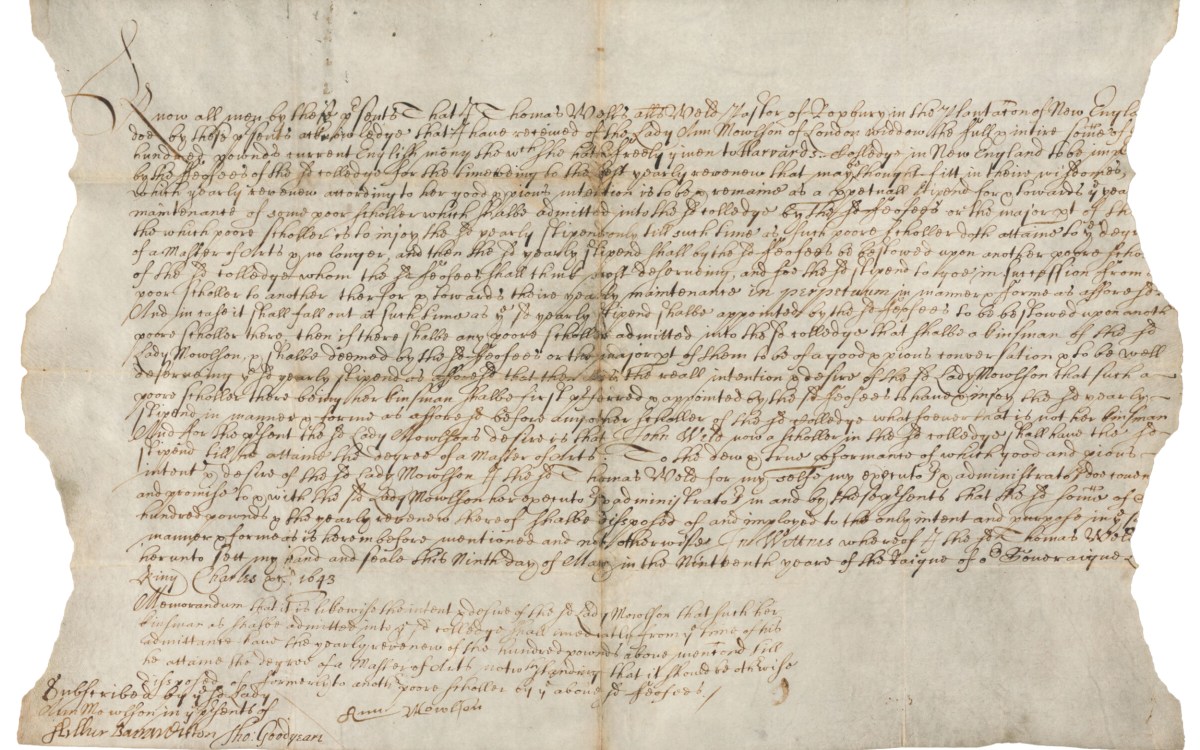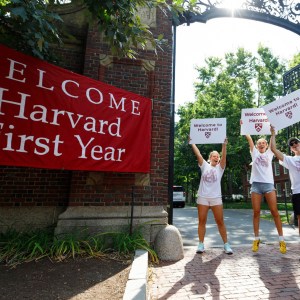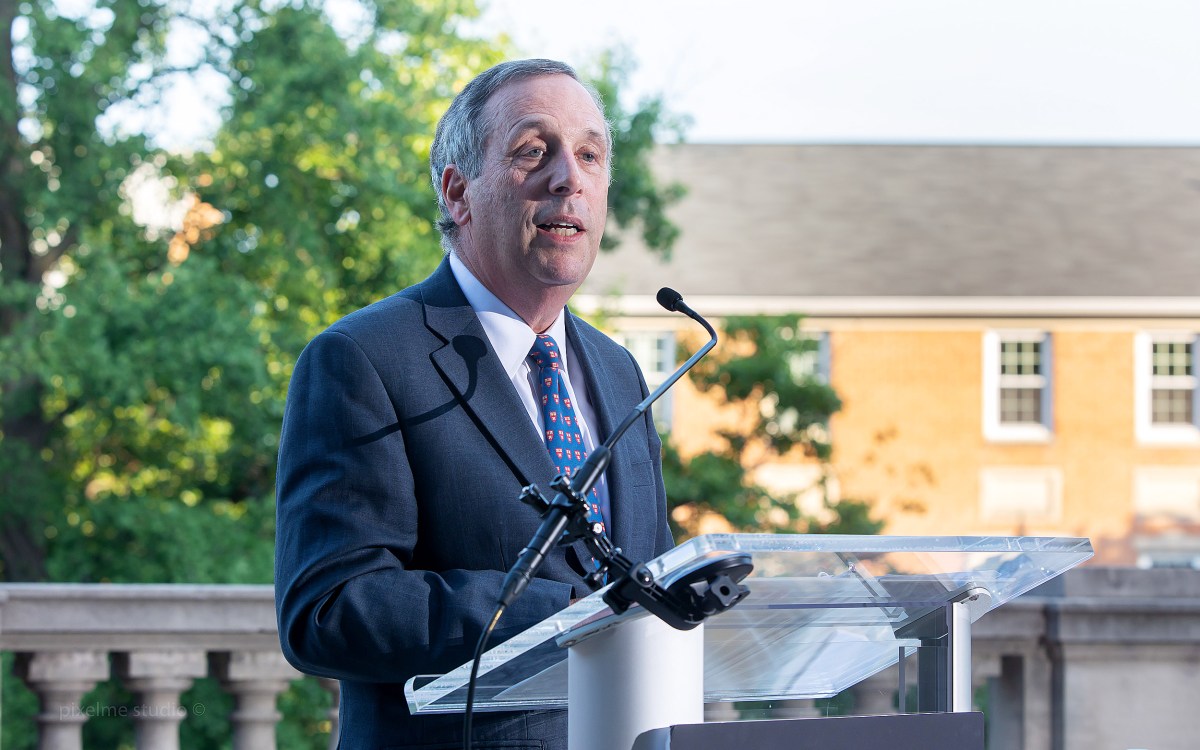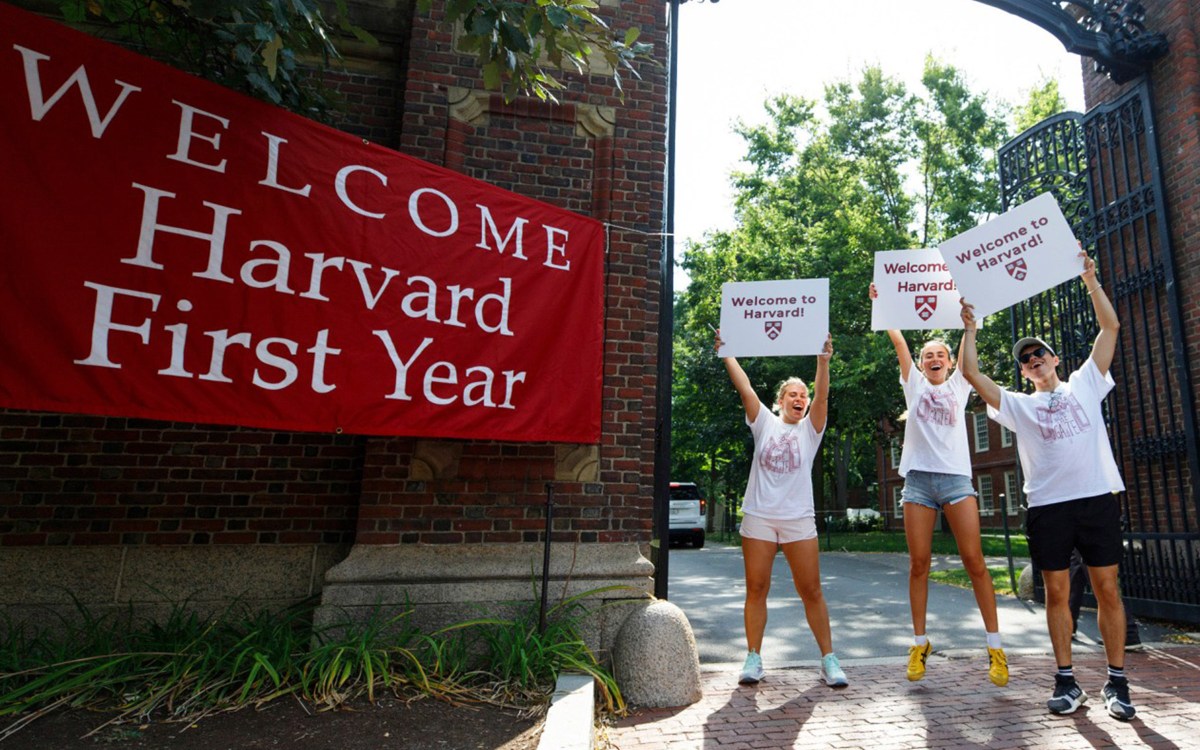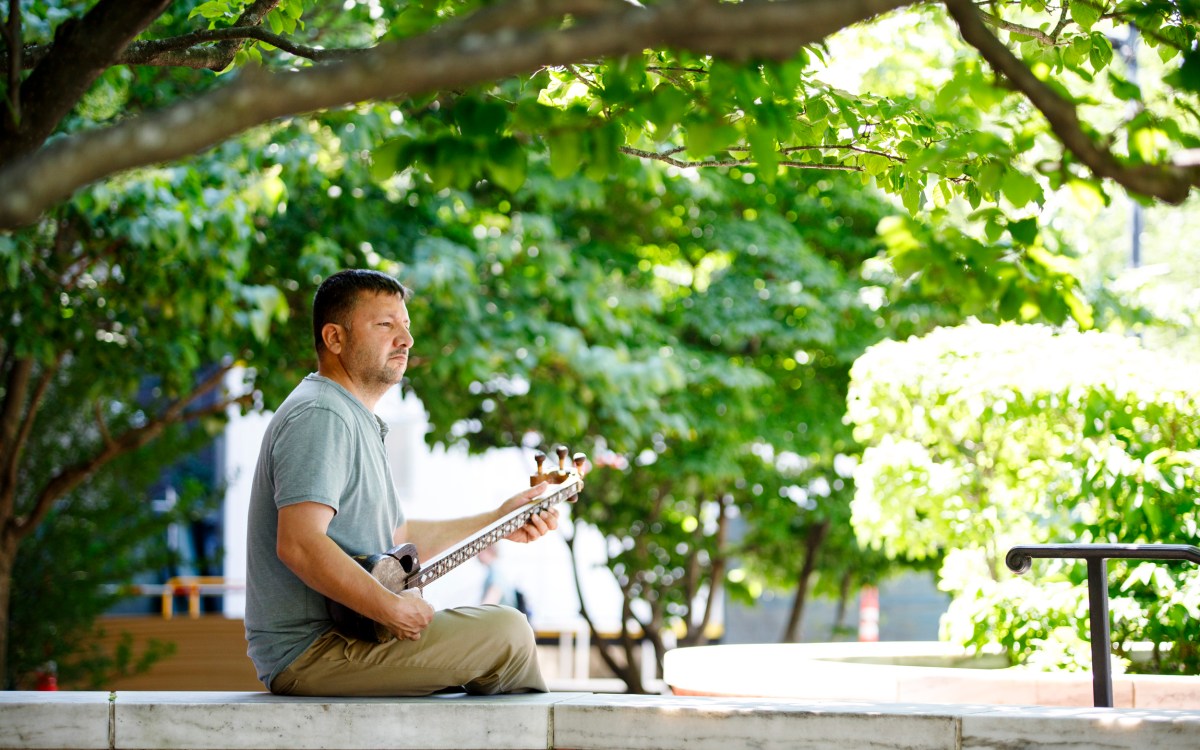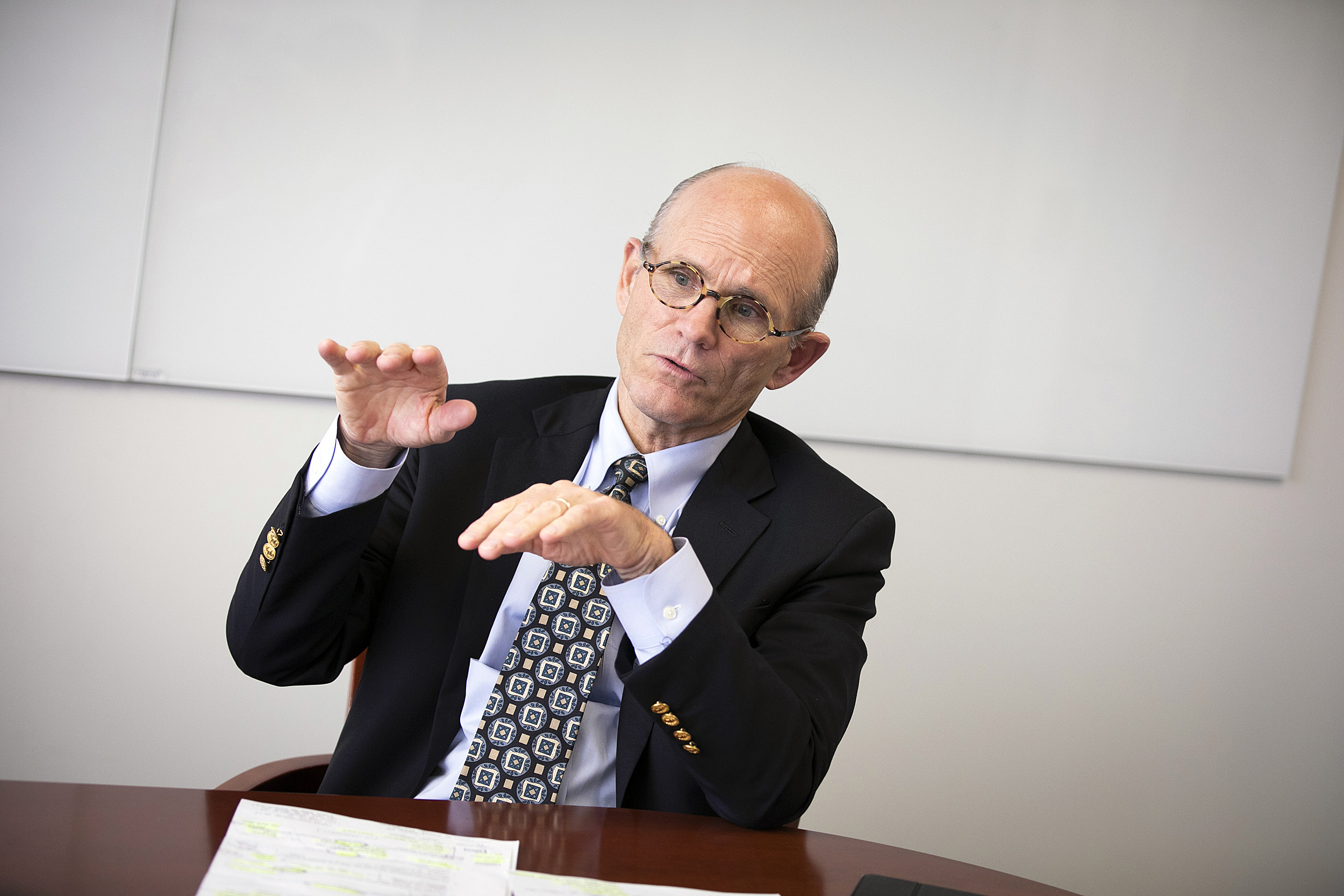
“It was a good year financially,” said Harvard chief financial officer and Vice President for Finance Thomas Hollister, in reflecting on the University’s annual financial report.
Photos by Stephanie Mitchell/Harvard Staff Photographer
A fairly bright fiscal 2019
But financial officials see dark clouds in the offing
With the 2019 budget year closing June 30, Harvard officials have been crunching the numbers that go into the University’s annual financial report. There is good news to share, according to Executive Vice President Katie Lapp and chief financial officer and Vice President for Finance Thomas Hollister. Fiscal 2019 ended with a $298 million surplus, a positive outcome, albeit one tempered by a forecast of challenges in the coming years. Lapp and Hollister sat down with the Gazette:
Q&A
Katie Lapp and Thomas Hollister
GAZETTE: So how did Harvard do in fiscal ’19?
HOLLISTER: It was a good year financially. Any time we have increased spending on financial aid and scholarships, University-funded research, investments in faculty and staff, and renewed classroom, lab, and common spaces, we’ve had a great outcome. A key point is that the University’s surplus is a consolidation of the Schools’ and units’ results. Surpluses are earned and used locally. They are a source of money for investment in the mission of Harvard, and it is the deans and department heads who make decisions about how to invest those monies, or whether to set them aside in rainy-day reserves, which will be very helpful when more troubling economic times come.
LAPP: I would add that the surplus is a reflection of the great work that’s being done across the University — by the deans, by the faculty, by the administrators, by people throughout the University — in determining how to use our resources to support research and education, figure out ways to be more efficient and reduce duplication, adopt new processes and technologies, and invest in our infrastructure and our people.
HOLLISTER: We should point out that about $112 million came from one-time revenues: an increase in royalty income of $72 million — which is hard to predict — and a $40 million gift that came in at the end of the year, of which little was spent before the year closed. As a percentage of revenue, our consolidated surplus is in the range of most AAA-rated peer institutions.
GAZETTE: The report looks ahead and says that we need to prepare for more difficult financial times. What do you see happening in the higher-education economy in the years ahead?
HOLLISTER: We’ve talked about this in the last few years. Higher education itself is changing demographically: The number of students is plateauing. There are affordability pressures and students and families are having difficulty paying for higher education. The other traditional sources of revenue are also all under pressure: Beyond tuition, federal funding of sponsored research is not increasing, and the outlook for endowment returns doesn’t look promising, according to most economists and investment market participants.
LAPP: There have really been some interesting changes. Executive education’s funding stream has been a source of additional resources to the Schools without changing their ultimate mission. Another change we’ve been talking about for some time is the digital landscape and understanding how that can be used to be more effective in how we educate students and use our talented faculty.
GAZETTE: It was interesting to see that the tuition from executive and continuing education is just a few million dollars shy of traditional tuition. Do we see that surpassing traditional tuition — it had a 12 percent growth rate — next year?
LAPP: It certainly could. I think this represents a shift in the way people view higher education. For many, it’s no longer just a four-year engagement or a two- or three-year engagement at the graduate level. Many people, in our alumni base and elsewhere, understand that the change in skills, in jobs, in what’s expected of people requires lifelong learning. Continuing education and executive education is tapping into that need. It has allowed the Schools to find ways to bring what they do, day in and day out, for their student body to a broader population.
HOLLISTER: The trajectories of the last few years suggest it will cross this year: There’ll be more tuition revenue from executive and continuing education than traditional degree-seeking programs. It’s important to say “net tuition” because the face value of tuition for traditional degree-seeking education, before financial aid and scholarships, was about $1.1 billion, but the net tuition that we received from students was about $500 million. The $600 million difference, which is financial aid and scholarships, is evidence that Harvard is trying to make education accessible to anybody who can apply and earn admission.
GAZETTE: The financial report talks about preparing for the next recession by building a downside into the next five-year budget. Why is that needed?
HOLLISTER: You could probably add “recession” to that old expression, “you can always count on death and taxes.” We’re 123 months into the longest economic expansion maybe in U.S. history, and we see indications that we’re toward the end of the cycle, with a backward-sloping yield curve and increasing volatility in the market. Led by Katie and others, the University is anticipating that a recession will occur and is taking the types of steps that will help prepare for it. All of our Schools and units are doing scenario planning, thinking through what they can or should be doing now to prepare for a variety of economic pressures. By the way, this certainly isn’t just about cutting costs. It’s really stepping back and asking, “What is essential to the mission? What do we intend to carry forward no matter what? Where will we invest more, perhaps while being efficient as well?”
GAZETTE: Let’s talk about the endowment. What is its importance to the University budget and how did that play out in the past year?
HOLLISTER: Philanthropy is crucial to Harvard’s aspirations for excellence in teaching and research. Fully 43 percent of the annual budget comes from philanthropy: 35 percent of it is the annual endowment distribution and the other 8 percent is current gifts. So, it is alumni and donors past and present who allow Harvard to try to realize its pursuit of excellence.
Harvard’s Executive Vice President Katie Lapp and Vice President for Finance Thomas Hollister share insight regarding Harvard’s $298 million surplus for 2019, while forecasting challenges in the coming years.
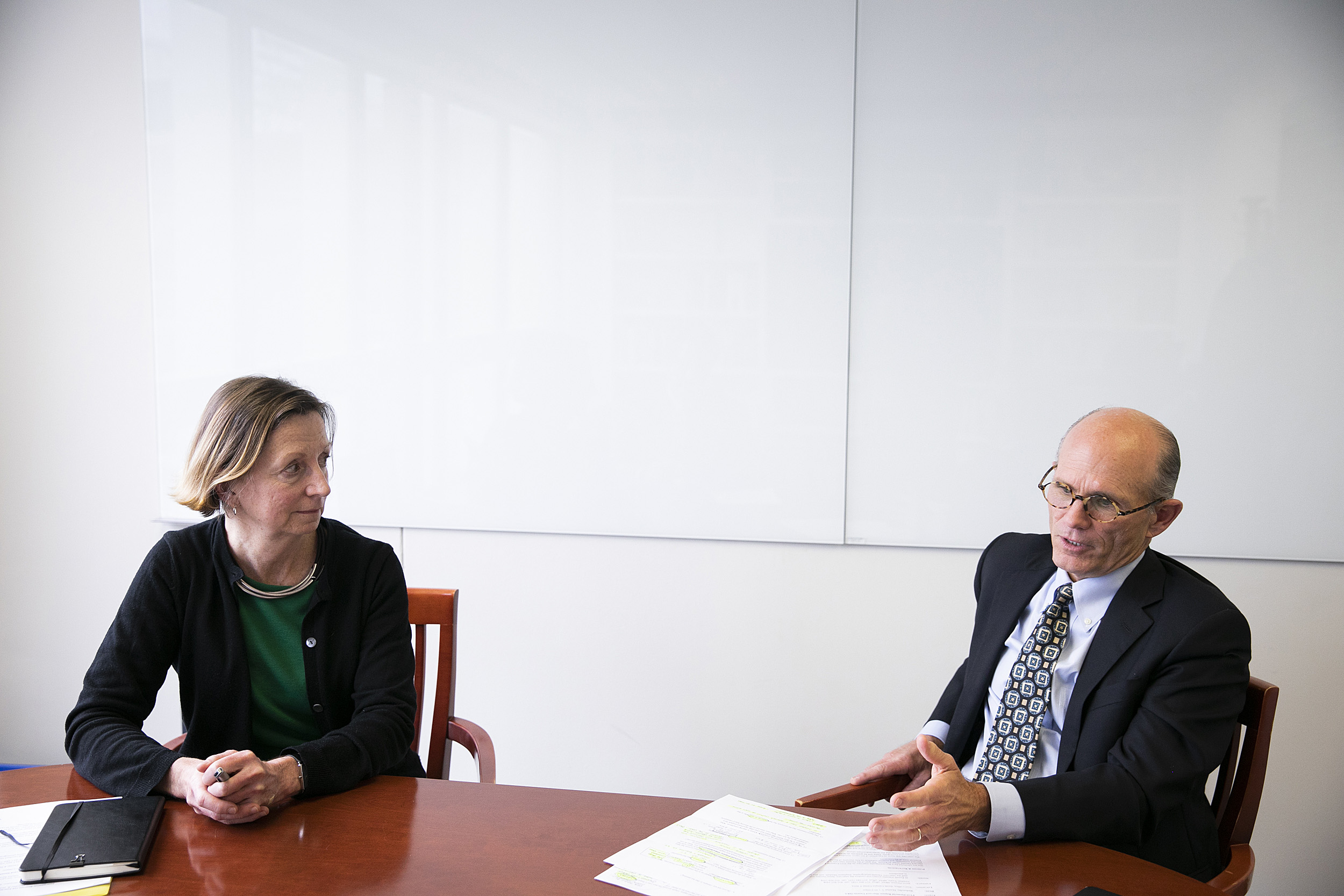
GAZETTE: The report talks about changes at Harvard Management Company, and last year’s return was down from 10 percent to 6.5 percent. What is the status of those changes?
HOLLISTER: We’re very fortunate to have Narv Narvekar running our endowment. Narv is superb at what he does and is proven in other settings. He has assembled tremendous talent, both from existing staff and people that he’s brought to HMC. They’re in the midst of a restructuring plan, which I happen to think is exactly correct. They have a very clear investment philosophy and very disciplined processes. If you talk to people in the investment business, they will concur that restructuring the illiquid portions of a portfolio with legacy assets takes time, and you can’t just snap your fingers. The progress is constant, painstaking, and heading in the right direction. As for last year’s results, there are many factors playing into that which Narv best describes in his letter in the annual report. I urge everyone to read it.
GAZETTE: Since we’re talking about giving, The Harvard Campaign concluded as fiscal 2019 began. Were there carry-on effects or other impacts on last year’s budget?
HOLLISTER: The campaign has made an enormous difference throughout the University. It has financed new spaces, new facilities, new professorships, as well as provided money for research and financial aid. The new endowed gifts will be invested and will support Harvard’s budget for generations to come.
Happily, current giving has increased substantially from precampaign levels. In 2019 it was almost $500 million. That is a critical source of unrestricted money for the University. It’s important to remember the power of each individual gift, no matter the size. Eighty percent of gifts this last year averaged $150. And despite the Campaign’s success, there are still unmet needs. Harvard’s undergraduate financial aid is not fully endowed, for example. The last number I saw is that it was a little over 60 percent endowed, so an economic downturn would put enormous pressure on the College’s ability to maintain the financial aid funding that helps provide access for all.
LAPP: Every single gift, whether a $150 or $150 million, represents a statement by the donor that Harvard is headed in the right direction. The numbers Tom quoted show that people understand that the leadership of the University, Larry Bacow — and before him, Drew Faust — and all the deans, the faculty, are doing a wonderful job. It’s an investment in the future of Harvard.
GAZETTE: Another financial constraint is the new federal tax on large university endowments. What has been the impact?
HOLLISTER: The amount of the tax that Harvard is expected to pay is preliminary, based on guidance that is still not finalized from the Treasury. But as a practical matter — we will send our first estimated payment in about 30 days — our best guess is the tax due for this past year is about $50 million. In context, that’s about 1 percent of our revenue, and, if you compare it to undergraduate financial aid, it’s more than 25 percent. That new burden limits our flexibility to support the mission of the University, particularly in difficult times.
LAPP: President Bacow has spent an enormous amount of time educating people about what this tax means. It means taking money that could otherwise go to support students and sending it to Washington. President Bacow is constantly speaking to members of Congress, the White House, and elsewhere, to make it clear that this tax really should be rethought so that the dollars that we’re sending to Washington can go back into things like financial aid.
GAZETTE: What about other expenditures? What were the big budget items?
HOLLISTER: It’s really people. Personnel are consistently about 50 percent of our expenses. Space — buildings, labs, classrooms — is another 20 percent. And the remaining 30 percent is goods, services, and miscellaneous items.
GAZETTE: The overall budget was up about 4 percent. Is that a reasonable annual target figure?
LAPP: Some of the increase is actually in areas where, thanks to the campaign, we have new investments. These are being paid or reimbursed by grants or other types of new revenue coming into the University. Generally speaking, we see things being managed very effectively. One of the things that President Bacow’s been focused on is working with our peer institutions — MIT, Boston University, Tufts — and seeing if there are ways we can cooperate in things that we all do. EdX is a good example, the MGHPCC — the Massachusetts Green High Performance Computing Center — is another. That is a partnership with MIT, BU, Northeastern, and UMass Boston to serve all of our computing needs.
GAZETTE: We spoke already about the surplus, but how about revenue specifically? How did we do with things like research funding?
HOLLISTER: Federal research funding was up 1 percent this past year. Nonfederal, which is on a smaller base, was up 6 percent. Our primary investigators, scientists, and professors are very entrepreneurial and seek out sources that will fund their great research. But as a percentage of our revenue it’s not a fast growth area. In fact, in the last few years it’s been 18 percent of our revenue, and this past year, it was 17 percent.
LAPP: In talking to the folks in Washington, Larry and the deans reinforce how important this revenue stream is to the future of the nation. This is the type of research that has made the United States the leader on so many fronts. I would add that, in addition to advances in technology, in health care, these dollars also help educate the next generation of researchers. Our faculty engage our students, undergraduate and graduate, in all this work. They will be the ones advancing research in the generations to come.
GAZETTE: Let’s talk about capital spending and construction. When will the Science and Engineering Complex be ready to open?
LAPP: It will open officially next fall, though people will be moving in during the spring.
GAZETTE: What other major projects have been recently completed or you are anticipating getting started?
LAPP: The Smith Center has been open for a year and has been a success beyond anyone’s expectations. We just had the ribbon-cutting for the ArtLab. That was a vision of Drew’s, adding art to the innovation community growing up in Allston. That’s been an amazing success. We’ve announced that the American Repertory Theater, thanks to the gift from David (’93) and Stacey Goel, will build a new facility in Allston, and we’re designing that right now. That’s another investment in the arts and in community-building that we’ll be doing in Allston. There’ve been a number of other projects. The Law School has a new building on Massachusetts Avenue. House renewal continues. We opened Lowell House and the renovation of Adams is underway. Work on Swartz Hall at the Divinity School is well underway.
HOLLISTER: And Schlesinger Library at Radcliffe.
LAPP: That’s true. There has also been considerable attention to deferred maintenance, to bring the buildings and facilities we already have up to an appropriate level of renewal. We have just finished — it is now operational — the district energy facility that will power not only the Science and Engineering Complex, but also buildings that are to come. It’s a great investment, and we’re making sure that we’re prepared for continued growth in Allston.
GAZETTE: How has progress on the Enterprise Research Campus gone?
LAPP: We have solicited bids from developers for the first phase of 14 acres and they’re being reviewed now. Our goal is to have a partner developer chosen by the end of the calendar year and begin planning for the buildings there, adjacent to the Science and Engineering Complex.
GAZETTE: Is the vision that it would leverage its proximity to the Business School and the Science and Engineering Complex?
LAPP: One of the goals for this undertaking is to create porosity among the Business School, the engineering school, the private development in the Enterprise Research Campus, and the innovation labs that are there, including the ArtLab.
GAZETTE: The report says the University has reduced its debt. Why was that a priority?
HOLLISTER: It’s no different than a household, a company, or a governmental entity. With debt, you don’t want too much, and in some cases, you don’t want too little. Harvard aspires to be prudent. We want to make sure that we always have the capacity to comfortably service our indebtedness and we want it structured in a way that is controllable. All of our debt is — almost without exception — low fixed rates. And it’s not “puttable,” so nobody can suddenly demand payment. Finally, we want accessibility at all times, so that we have unused capacity if and when we need it.
GAZETTE: Our interest costs have come down? Is that money that can be used elsewhere?
HOLLISTER: Exactly. We’d much rather pay a scholarship than a bank.
